Mathura
Mathura (![]()
Mathura | |
|---|---|
 .jpg) 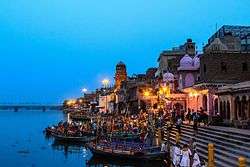 .jpg) Clockwise from top : Mathura Museum, Chhatris of Barsana, Vishram Ghat on banks of river Yamuna, one of the many Ancient Temple in Mathura, Sri Rangaaji Temple, Old street in front of the Krishna Mandir and Jai Gurudev Temple | |
| Nickname(s): Krishnanagri; The City of Lord Krishna | |
 Mathura 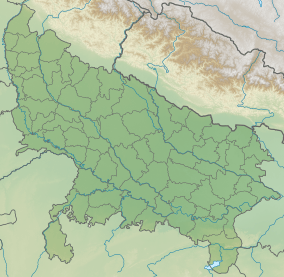 Mathura 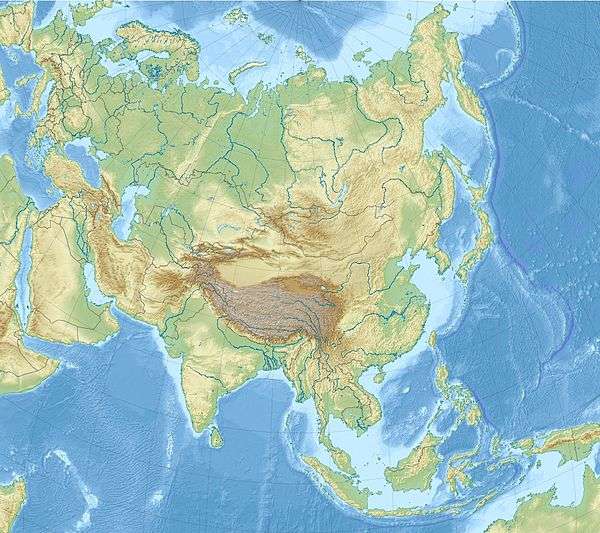 Mathura | |
| Coordinates: 27°29′33″N 77°40′25″E | |
| Country | |
| State | Uttar Pradesh |
| District | Mathura |
| Government | |
| • Type | Municipal Corporation |
| • Body | Mathura Municipal Corporation |
| • Mayor[1] | Mukesh Aryabandhu (BJP) |
| • District Magistrate and Collector | Sarvagya Ram Mishra, IAS[2] |
| • Senior Superintendent of Police | Gaurav Grover IPS[3] |
| • Member of Legislative Assembly | Shrikant Sharma (BJP) |
| • Member of Parliament | Hema Malini (BJP) |
| Population (2011) | |
| • Total | 441,894 |
| Language | |
| • Official | Hindi[4] |
| • Additional official | Urdu[4] |
| • Regional | Braj Bhasha |
| Time zone | UTC+5:30 (IST) |
| PIN | 281001 |
| Telephone code | 0565 |
| Vehicle registration | UP-85 |
| Website | mathura |
| Pilgrimage to |
| Buddha's Holy Sites |
|---|
 |
| The Four Main Sites |
| Four Additional Sites |
| Other Sites |
|
| Later Sites |
|
In Hinduism, Mathura is believed to be the birthplace of Krishna, which is located at the Krishna Janmasthan Temple Complex.[5] It is one of the Sapta Puri, the seven cities considered holy by Hindus. The Kesava Deo Temple was built in ancient times on the site of Krishna's birthplace (an underground prison). Mathura was the capital of the kingdom of Surasena, ruled by Kansa, the maternal uncle of Krishna. Janmashtami is grandly celebrated in Mathura every year.
Mathura has been chosen as one of the heritage cities for the Heritage City Development and Augmentation Yojana scheme of Government of India.[6]
History

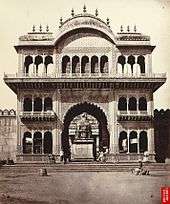
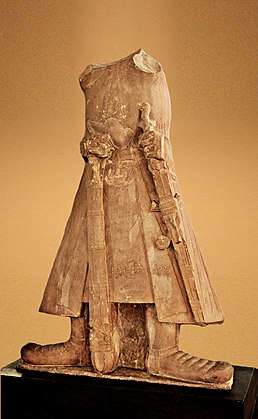
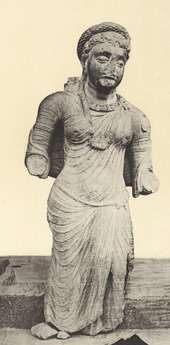
Mathura has an ancient history and also believed to be the homeland and birthplace of Krishna who was born in Yadu dynasty. According to the Archaeological Survey of India plaque at the Mathura Museum,[7] the city is mentioned in the oldest Indian epic, the Ramayana. In the epic, the Ikshwaku prince Shatrughna slays a demon called Lavanasura and claims the land. Afterwards, the place came to be known as Madhuvan as it was thickly wooded, then Madhupura and later Mathura.[8]
Archaeological excavations at Mathura show the gradual growth of a village into an important city. The earliest period belonged to the Painted Grey Ware culture (1100-500 BCE), followed by the Northern Black Polished Ware culture (700-200 BCE). Mathura derived its importance as a center of trade due to its location where the northern trade route of the Indo-Gangetic Plain met with the routes to Malwa (central India) and the west coast.[9]
By the 6th century BCE Mathura became the capital of the Surasena Kingdom.[10] The city was later ruled by the Maurya empire (4th to 2nd centuries BCE). Megasthenes, writing in the early 3rd century BCE, mentions Mathura as a great city under the name Μέθορα (Méthora).[11] It seems it never was under the direct control of the following Shunga dynasty (2nd century BCE) as not a single archaeological remain of a Shunga presence were ever found in Mathura.[12]
The Indo-Greeks may have taken control, direct or indirect, of Mathura some time between 180 BCE and 100 BCE, and remained so as late as 70 BCE according to the Yavanarajya inscription,[12] which was found in Maghera, a town 17 kilometres (11 mi) from Mathura.[13] The opening of the 3 line text of this inscription in Brahmi script translates as: "In the 116th year of the Yavana kingdom..."[14][15] or '"In the 116th year of Yavana hegemony" ("Yavanarajya")[12] However, this also corresponds to the presence of the native Mitra dynasty of local rulers in Mathura, in approximately the same time frame (150 BCE—50 BCE), possibly pointing to a vassalage relationship with the Indo-Greeks.[12]
After a period of local rule, Mathura was conquered by the Indo-Scythians during the first 1st century BCE. The Indo-Scythian satraps of Mathura are sometimes called the "Northern Satraps", as opposed to the "Western Satraps" ruling in Gujarat and Malwa. However, Indo-Scythian control proved to be short lived, following the reign of the Indo-Scythian Mahakshatrapa ("Great Satrap") Rajuvula, c. 10–25 CE.
The Kushan Empire took control of Mathura some time after Rajuvula, although several of his successors ruled as Kushans vassals, such as the Indo-Scythian "Great Satrap" Kharapallana and the "Satrap" Vanaspara, both of whom paid allegiance to the Kushans in an inscription at Sarnath, dating to the 3rd year of the reign of the Kushan emperor Kanishka c. 130 CE.[16] Mathuran art and culture reached its zenith under the Kushan dynasty which had Mathura as one of its capitals.[17] The preceding capitals of the Kushans included Kapisa (modern Bagram, Afghanistan), Purushapura (modern Peshawar, Pakistan) and Takshasila/Sirsukh/ (modern Taxila, Pakistan). During 3rd century Nagas ruled Mathura after decline of Kushan Empire.[18]
Chinese Buddhist Monk Faxian mentions the city as a centre of Buddhism about 400 CE. He found the people were very well off, there were no taxes other than for those on farmers who tilled the royal land. He found that people did not kill animals, no one consumed wine, and did not eat onion or garlic. He found that engraved title deeds were issued to land owners. Visiting priests were provided with accommodation, beds, mats, food, drinks and clothes to perform scholarly works.[19] Xuanzang, who visited the city in 634 CE, mentions it as Mot'ulo, recording that it contained twenty Buddhist monasteries and five Hindu temples.[20] Later, he went east to Thanesar, Jalandhar in the eastern Punjab, before climbing up to visit predominantly Theravada monasteries in the Kulu valley and turning southward again to Bairat and then Mathura, on the Yamuna river.[21]
The city was sacked and many of its temples destroyed by Mahmud of Ghazni in 1018 CE[20] and again by Sikandar Lodhi, who ruled the Sultanate of Delhi from 1489 to 1517 CE.[22][23] Sikander Lodhi earned the epithet of 'Butt Shikan', the 'Destroyer of Hindu deities'. The Mughal Emperor Aurangzeb, built the Shahi-Eidgah Mosque during his rule, which is adjacent to Shri Krishna Janmabhoomi believed to be over a Hindu temple.[24] He also changed the city's name to Islamabad.[25]
Religious heritage
Mathura is a holy city for Hinduism and is considered the heart of Brij Bhoomi, the land of Krishna.[26][27] The twin-city to Mathura is Vrindavan.
There are many places of historic and religious importance in Mathura and its neighbouring towns.[6]
Krishna Janmasthan Temple Complex is an important group of temples built around what is considered to be the birthplace of Krishna.[28][29] The temple complex contains Keshav Deva temple, Garbha Griha shrine, Bhagavata Bhavan and the Rangabhoomi where the final battle between Krishna and Kamsa took place.[30][5][7][28]
The Dwarkadheesh Temple is one of the largest temple in Mathura.[5] Vishram Ghat at the bank of river Yamuna is said to be the place were Krishna had rested after killing Kamsa.[5]
Other notable Hindu religious sites and heritage locations includes Shri Shweat Varah Temple and the main deity of the temple is siad to dating prior to Ramayan era,the Gita Mandir,[31] Govind Dev temple,[31] Iskcon temple,[5] Kusum Sarovar,[31] Naam yog Sadhna Mandir, Peepleshwar Mahadeo Temple[32][33] and Yum Yamuna Temple[32]
Jama Mosque, Mathura is a notable site for Islam. It was completed by Abd-un-Nabi, governor of Aurangzeb in 1662.
The Mathura Museum is notable for archaeological artefacts, especially those from the Kushan and Gupta empires. It has sculptures associated with Hinduism, Buddhism and Jainism.[7][34]
Festivals
Janmashtami is grandly celebrated every year in Mathura with. Every year 3 to 3.5 million devotees celebrate Janmashtami in Mathura, with most number of people in Keshav Deva temple and Dwarkadheesh temple.[35][36] People generally observe a fast and break it at midnight when Lord Krishna was believed to have been born. Devotional songs, dance performances, bhog and aartis are observed across Mathura-Vrindavan.[37]
Geography
Mathura is located at 27.28°N 77.41°E.[38] It has an average elevation of 174 metres (570 feet).
Demographics
The 2011 census of India estimates the population of Mathura to be 441,894, a decadal growth rate of 22.53 per cent from 2001 census of India. Males account for 54% (268,445) and females for 46% (173,449) of this population. Sex ratio of Mathura is 858 females per 1000 males, which has increased from 840 in 2001. However, national sex ratio is 940. Population density in 2011 has increased from 621 per km2 in 2001 to 761 per km2. Mathura has an average literacy rate of 72.65 per cent which has increased from 61.46 percent in 2001 but still lower than the national average of 74.04 per cent. Male and female literacy rate are 84.39 and 58.93 per cent respectively. 15.61 percent of Mathura's population is under 6 years of age. This figure was 19.56 per cent in 2001 census.[39]
Transportation
Rail
Mathura Junction railway station is situated on the major Delhi-Mumbai train route. Both Central Railway and Western Railway routes pass through Mathura. Trains from NCR (north-central railway) to ER (eastern railway) also pass from the Mathura junction railway station. Mathura Cantt railway station is a major route for an eastern and central railway.
Important train that origin/terminate from Mathura: 12177/Howrah - Mathura Chambal Express.[40]
Road
Mathura is connected by road to the rest of Uttar Pradesh and India. NH-19 (NH-2 as per old numbering system) which is having connectivity from Delhi to Kolkata and diversion for Chennai also passes from Mathura. Yamuna expressway Greater-Noida to Agra(165 km 6 lane access controlled express highway) also passes from here so there is connectivity to Noida and Agra and Lucknow.
Tram
A tram network has been proposed in the city, which would make Mathura only the second city in India (after Kolkata) to get tram transport. In 2017, the local MLA Shrikant Sharma announced that the trams will be operation in Mathura and Vrindavan by 2018.[41]
Air
Currently the city has no airport, nearest airport is Agra (about 60 km away) and Delhi Airport (about 160 km away) with major national and international air routes. Under-construction Jewar Airport in Greater Noida will be approximately 75 km away from Mathura and is expected to be country's largest airport when fully operational. Land has been earmarked, and construction is in progress near the Yamuna Expressway, with plans to open in the next five years with regular flights to major national and international air routes in future.[42][43][44]
Then civil aviation minister Ajit Singh suggested Mathura's name for the site of a new greenfield international airport to the chief minister of Uttar Pradesh Akhilesh Yadav in 2012. Mathura's name came into play when group of ministers terminated the planning of building Taj International Airport at Agra.
Strategic importances
Mathura is the home for I Corps (Strike Formation)[45][46] within the Indian Army's Central Command, hosting Strike I Corps headquarters in a large classified area in the outskirts of the city known as Mathura Cantonment (Central Command itself has its headquarters at Lucknow). It hosts Strike Infantry units, air defence units, armoured divisions, engineer brigades, artillery Units, and classified units of Strategic Forces Command. The I Corps is primarily responsible for the western borders of India. In 2007 during Exercise Ashwamedha, all the armoured, artillery, and infantry divisions performed a simulation of an overall NBC (nuclear-chemical-biological) environment. The aim was to show operational ability in high intensity, short duration and 'sudden' battles.[47]
Industries
Mathura Refinery located in the city is one of the biggest oil refineries of Asia with 8.0 million tonnes per year refining capacity.[48] This oil refinery of the Indian Oil Corporation is a highly technologically advanced oil refinery and provides local employment opportunities.[48]
Media and communications
All India Radio has a local station in Mathura which transmits various programs of interest.
Educational institutions
See also
- Brij Bhoomi
- Gokul
- Kankali Tila
References
- "Mathura-Vrindavan Mayor Election Result 2017 Live Updates: BJP candidate Mukesh Arya is new Mayor". 1 December 2017.
- "DM PROFILE | District Mathura, Government of Uttar Pradesh | India".
- "Uttar Pradesh Police | Officials". uppolice.gov.in. Retrieved 9 January 2020.
- "52nd REPORT OF THE COMMISSIONER FOR LINGUISTIC MINORITIES IN INDIA" (PDF). nclm.nic.in. Ministry of Minority Affairs. Archived from the original (PDF) on 25 May 2017. Retrieved 7 December 2018.
- Prasad, Dev (2015). Krishna: A Journey through the Lands & Legends of Krishna. Jaico Publishing House. p. 22. ISBN 978-81-8495-170-7.
- "Mathura: Mathura gets five more 'teerth sthals' | Agra News - Times of India". The Times of India.
- Frederic Salmon Growse (1874). Mathura: A District Memoir. British Library.
- Pargiter, F.E. (1972). Ancient Indian Historical Tradition, Delhi: Motilal Banarsidass, p.170.
- Upinder Singh (2008). A History of Ancient and Early Medieval India: From the Stone Age to the 12th Century. Pearson Education India. pp. 281, 336. ISBN 978-81-317-1120-0.
- "Imperial Gazetteer of India. v. 18". Digital South Asia Library. 1908. pp. 63–74.
- Megasthenes, fragment 23 "The Surasenians, an Indian tribe, with two great cities, Methora and Clisobora; the navigable river Iomanes flows through their territory" quoted in Arrian Indica 8.5. Also "The river Jomanes (Yamuna) flows through the Palibothri into the Ganges between the towns Methora and Carisobora." in FRAGM. LVI. Plin. Hist. Nat. VI. 21. 8-23. 11. Archived 10 December 2008 at the Wayback Machine
- History of Early Stone Sculpture at Mathura: Ca. 150 BCE - 100 CE, Sonya Rhie Quintanilla, BRILL, 2007, p.8-10
- Bulletin of the Asia Institute. Wayne State University Press. 2002. p. 70.
- B. N. Mukherjee (2004). Kushāṇa studies: new perspectives. Firma KLM. p. 13. ISBN 81-7102-109-3.
- Osmund Bopearachchi; Wilfried Pieper (1998). Ancient Indian coins. Brepols. ISBN 2-503-50730-1.
- A Catalogue of the Indian Coins in the British Museum. Andhras etc.... Rapson, p. ciii.
- Singh, Upinder (2008). A History of Ancient and Early Medieval India: From the Stone Age to the 12th Century. Pearson Education India. ISBN 9788131716779. Retrieved 29 March 2017.
- Ashvini Agrawal 1989, p. 54.
- Beal, Samuel (1884). Si-Yu-Ki: Buddhist Records of the Western World (translated from chinese). London: Truebner & Co.
- Chisholm, Hugh, ed. (1911). . Encyclopædia Britannica. 19 (11th ed.). Cambridge University Press. pp. 101–102. (Mathura)
- Yule, Henry; Douglas, Robert Kennaway (1911). . In Chisholm, Hugh (ed.). Encyclopædia Britannica. 13 (11th ed.). Cambridge University Press. p. 844.
- Sultan Sikandar Lodi Archived 4 March 2016 at the Wayback Machine The Muntakhabu-'rūkh by Al-Badāoni (16th-century historian), Packard Humanities Institute.
- Lodi Kings: Chart The Imperial Gazetteer of India, 1909, v. 2, p. 369..
- Asher, Catherine B (24 September 1992). Architecture of Mughal India. ISBN 9780521267281.CS1 maint: ref=harv (link)
- Fisher, Michael H. (2018). An Environmental History of India: From Earliest Times to the Twenty-First Century. Cambridge University Press. p. 109. ISBN 978-1-107-11162-2.
- Prasad, Dev (2015). Krishna: A Journey through the Lands & Legends of Krishna. Jaico Publishing House. p. 16. ISBN 978-81-8495-170-7.
- Lucia Michelutti (2002). "Sons of Krishna: the politics of Yadav community formation in a North Indian town" (PDF). PhD Thesis Social Anthropology. London School of Economics and Political Science University of London. p. 46. Retrieved 14 September 2019.
- Krishna, Nanditha (2018). The Book of Avatars and Divinities. Penguin Random House India. ISBN 9780143446880.
- Vemsani, Lavanya (2016). Krishna in History, Thought, and Culture: An Encyclopedia of the Hindu Lord of Many Names: An Encyclopedia of the Hindu Lord of Many Names. ABC-CLIO. pp. 140–141. ISBN 978-1-61069-211-3.
- Aug 2019, ANI | 24; Ist, 07:07 Pm. "Devotees throng 'Krishna Janmbhumi' in UP's Mathura on occasion of 'Janmashtami'" – via economictimes.indiatimes.com.
- "The Famous Temples of Mathura - Times of India".
- "Exploring 5 ancient temples of Mathura". Times of India Travel.
- Lal, Kanwar(1961). Holy Cities of India, Delhi : Asia Press, p.285.
- "The Sunday Tribune - Spectrum - Travel". www.tribuneindia.com. Retrieved 13 September 2019.
- Jaiswal, Anuja (3 September 2018). "Over 30 lakh devotees assemble in Mathura to celebrate Krishna Janmashtami | Agra News - Times of India". The Times of India. Retrieved 14 September 2019.
- "One million devotees celebrate Janmashtami in Mathura". Deccan Herald. 28 August 2013. Retrieved 12 September 2019.
- "Janmashtami 2019: 23rd or 24th Aug- when Mathura is celebrating Lord krishna's birth?". DNA India. 22 August 2019. Retrieved 14 September 2019.
- "Maps, Weather, and Airports for Mathura, India". Retrieved 3 June 2016.
- "Provisional Population Totals Paper 1 of 2011 : Uttar Pradesh". 2011 Census of India. Ministry of Home Affairs, Government of India. Retrieved 10 February 2013.
- Ahmad, F. "12177/Howrah - Mathura Chambal Express - Howrah to Mathura NCR/North Central Zone - Railway Enquiry". indiarailinfo.com.
- "Mathura to get tram network by 2018 | Lucknow News - Times of India". The Times of India.
- "International airport now at Mathura". 22 May 2012. Retrieved 3 June 2016.
- Srivsatava, Piyush (20 December 2012). "Akhilesh's plan of an international airport in Agra may not take off". India Today. Retrieved 30 January 2020.
- "Centre invites proposal from UP for airport near Mathura - Times of India". Retrieved 3 June 2016.
- Pike, John. "India - Army Central Command Order of Battle". Retrieved 3 June 2016.
- "www.bharat-rakshak.com/LAND-FORCES/Army/Organisation.html". Archived from the original on 19 February 2009. Retrieved 3 June 2016.
- "www.india-defence.com/reports/3115". Archived from the original on 5 February 2012. Retrieved 3 June 2016.
- "IndianOil Corporation | Mathura Refinery". Iocl.com. Retrieved 17 November 2013.
- "Mathura University". Upvetuniv.edu.in. 25 October 2001. Archived from the original on 11 December 2013. Retrieved 17 November 2013.
- Mathura-The Cultural Heritage. Edited by Doris Meth Srinivasan, published in 1989 by AIIS/Manohar.
- Konow, Sten. Editor. 1929. Kharoshthī Inscriptions with Exception of those of Ashoka. Corpus Inscriptionum Indicarum, Vol. II, Part I. Reprint: Indological Book House, Varanasi, 1969.
- Mukherjee, B. N. 1981. Mathurā and its Society: The Śaka-Pahlava Phase. Firma K. L. M. Private Limited, Calcutta.
- Sharma, R. C. 1976. Mathura Museum and Art. 2nd revised and enlarged edition. Government Museum, Mathura.
- Growse, F. S. 1882. " Mathura A District Memoir.
- Drake-Brockman, D. L. 1911. " Muttra A Gaztteer.
- The Jain stûpa and other antiquities of Mathura, by Smith, Vincent Arthur, 1848–1920. (1901)
- 1018: Mahmud Ghazni’s invasion of Mathura
External links
| Wikiquote has quotations related to: Mathura |
| Wikimedia Commons has media related to Mathura. |
| Wikivoyage has a travel guide for Mathura. |
